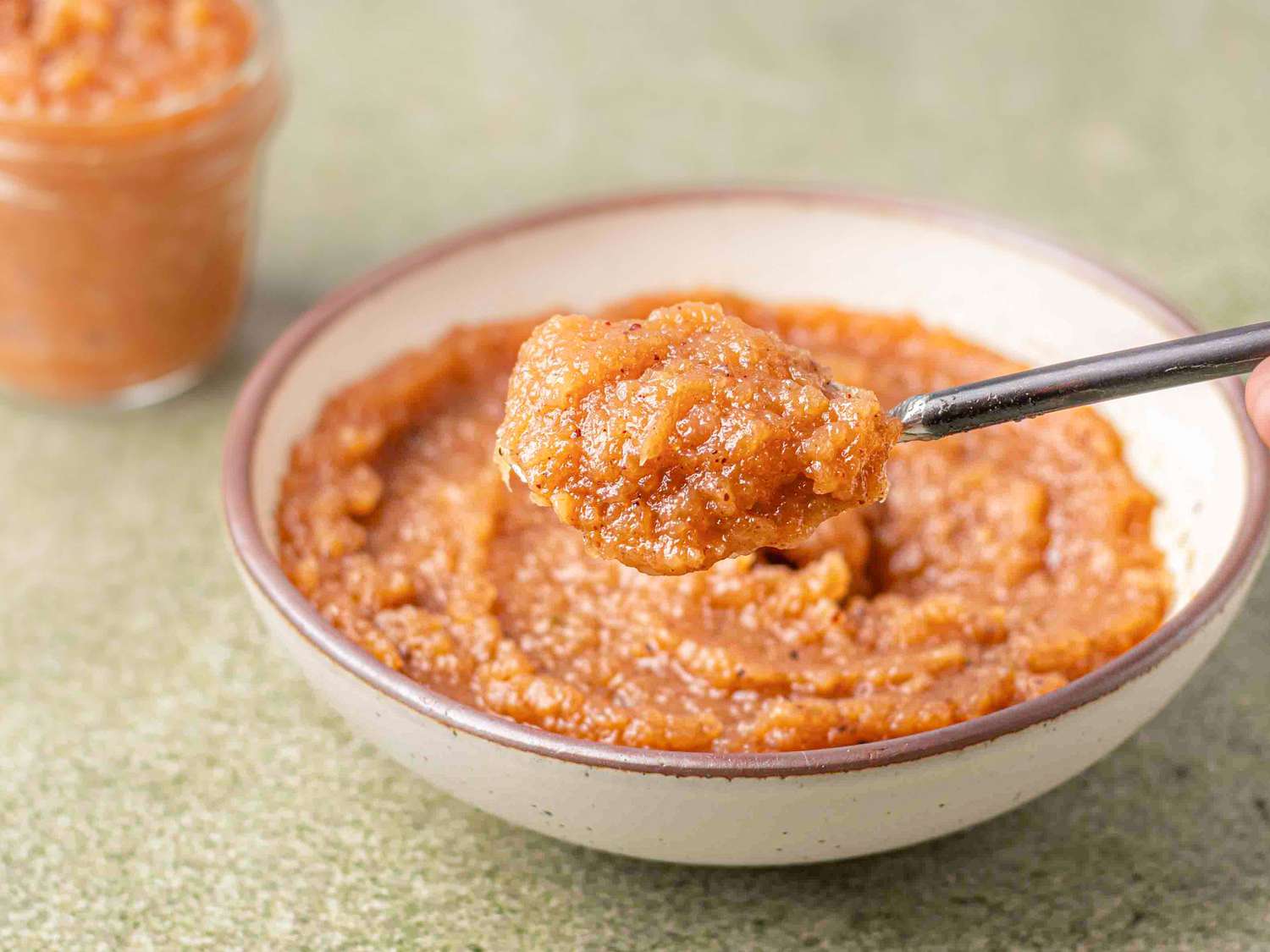Why It Works
- The combination of warming spices, chiles, and aromatics gives the applesauce depth and complexity.
- Using both apple cider vinegar and apple cider enhances the apple flavor.
- There is a lot of flexibility in the final texture of the sauce—you can mash or puree all or some, as desired.
I love applesauce now but I didn’t always. It wasn’t a part of my childhood in Nigeria, and it wasn’t until my early twenties (while studying geology in the UK) that I first had applesauce—that first experience was with jarred Bramley applesauce paired with roast pork for Christmas dinner. Later, when I moved to the Netherlands for work, I discovered that applemoes (applesauce) is a table essential that most Dutch people develop a love for at a young age. It’s served with everything—pancakes, boiled and fried potatoes, sausages, and even chicken, and no children’s menu at a restaurant is complete without it.
I was determined not only to learn to enjoy applesauce but also how to make it. My conversion to the ranks of applesauce fans stemmed from my three young children who encountered it often when we lived in the Netherlands, particularly my son who went to a Dutch kinderopvang (kindergarten). At birthday parties, Pannenkoekenhuizen (pancake houses) and restaurants, school trips to orchards, and weekend activities, my world of apples and possibilities expanded—I tried applesauce with mayo and fries, pancakes, meats, and more. Back in my kitchen I explored new recipes with apples for cakes and bakes, toddies, tarts, curds, and—you guessed it—sauce.
Serious Eats / Maureen Celestine
The resulting applesauce that I’ve grown to love and make at home is a thick, brown, speckled sauce, full of apple flavor. It celebrates my love of sweet, sour, and spicy notes combined in one bite. It’s balanced, comforting, and decidedly savory enough to pair with a variety of meals but it can also be enjoyed all on its own as a snack. I particularly like it served with cheese and roast pork. Here are a few tips to make my ideal version of applesauce at home.
The Best Apples for Applesauce
In theory, applesauce can be made with any type of apple. They’re just chopped and cooked down to mush, so how much does the apple variety really matter? But this assumption is wrong. To me, selecting a variety of apple that is both sweet and tart is important for applesauce that can be paired with a variety of spices. My preferred apples for this applesauce recipe are Cripps Pink apples, also sold as Pink Lady apples. A popular winter apple, this variety is my favorite for eating out-of-hand and for cooking—they have crisp, firm yet juicy flesh and when cooked down into applesauce, a refreshing sweet-tart flavor that pairs well with the warming spices and aromatics .
Hit a Wide Range of Flavor Notes with Warm Spices and Savory Aromatics
While the Dutch applesauce I had grown to love was simple, with no seasonings except for an occasional sprinkle of cinnamon, I prefer to add a variety of warm spices and aromatics to my applesauce to create an unexpected savory and complex flavor. The apples are enhanced with warming spices such as cinnamon, coriander seeds, ginger, and chiles; aromatics like red onions (use shallots if you like) and garlic; and acid from apple cider vinegar and fresh lemon juice. Angostura bitters add a hint of bitterness and complexity, echoing some of the warm and spicy flavors of cinnamon and cloves.
This recipe calls for toasted mustard seeds, which lend some spice to the mix. When cracked and mixed with liquid, as in this recipe, mustard seeds become pungent. If you don’t like the classic funky aroma (think kala namak, a.k.a. black salt), leave them whole. If you decide to crack them in a mortar and pestle, know that this is an art—one I have mustared 🙂 over the years! Place your nondominant hand over the top of the mortar, leaving a slot between your thumb and forefinger for the pestle;this will secure the mortar in place. Then grind, applying pressure in a circular motion to ensure all of the small seeds are cracked in the process.
Mash the Applesauce Any Way You Choose
Cripps pink apples hold together well when fully cooked so you won’t be able to tell when the apples are done just by looking at the cooked mixture. The best way to check to see whether the apples are fully tender is to press a few apple pieces against the side of the pot with a spoon or spatula; when fully cooked, the apples will turn mushy and fall apart easily. At this point they are ready to mash. For a chunkier applesauce like I prefer, use a potato masher or the back or a wooden spoon to break the apple pieces into a chunky applesauce. Or, if you prefer applesauce with a silkier texture, transfer the apple mixture to a food processor or blend with an immersion blender until smooth. Just make sure to remove the cinnamon stick before blending.
Serious Eats / Maureen Celestine
What I especially enjoy about this recipe is that you can adjust the seasonings to suit your preferences and still end up with delicious applesauce. Serve with cheese or meats, bake it into savory tarts and pies, or enjoy it all on its own, just like I do.


